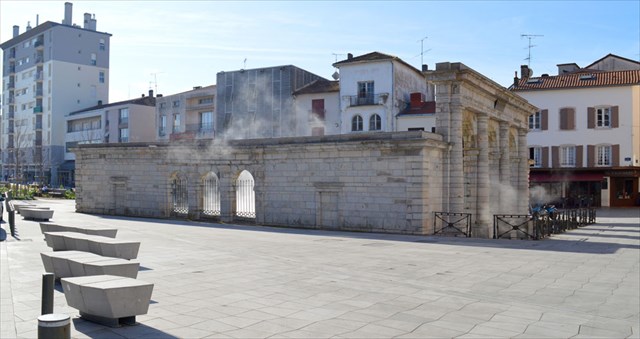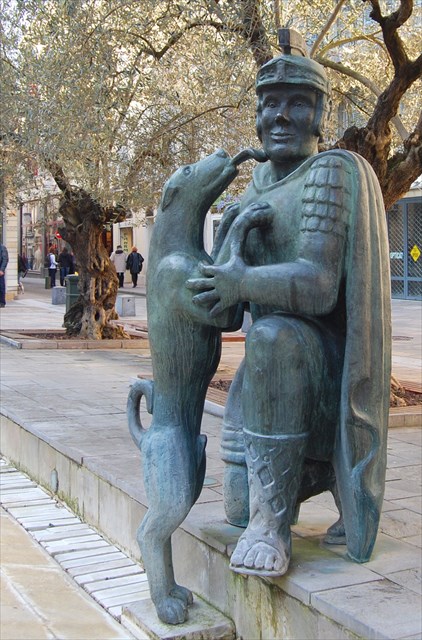|

Fontaine d'eau chaude
Dès l’Antiquité cette source est vénérée, et durant les siècles suivants son eau chaude sera précieuse pour tous.

Une légende est solidement accrochée à la découverte des bienfaits des eaux chaudes de Dax ; c’est la légende du « chien du légionnaire ». Un légionnaire romain en garnison à Dax avait un chien perclus de rhumatismes. Partant en campagne et sachant que son pauvre chien ne pourrait pas le suivre, il résolut de le noyer dans l’Adour pour le soustraire aux tortures de la faim. S'armant de courage, il le jeta dans le fleuve. Quand le légionnaire revint, il eut la surprise de retrouver son chien revigoré par la boue thermale dans laquelle il avait échoué, au bord du fleuve.
Le thermalisme était né.

Autour de la Fontaine chaude s’élevait autrefois le quartier des tripiers et des bouchers ; les ménagères se servaient de l'eau chaude de la fontaine pour cuire les œufs ou plumer les volailles.
L’actuel portique de style toscan a été construit en 1814, sous Louis XVIII, à l'emplacement d’un ancien bassin gallo romain, remanié à de multiples reprises au cours des siècles.
Les sources thermales de Dax naissent d'une faille datant de l’érection des Pyrénées. On est en présence d'un circuit souterrain d'une longueur très importante, où la température élevée et la minéralisation de l'eau sont acquises à une grande profondeur, de l'ordre de 2 000 mètres.
Dans le bassin de la Fontaine Chaude, on peut apercevoir une floraison d’algues. Celles-ci, mélangées avec le limon de l’Adour et l’eau thermale, entrent dans la composition de la boue thermale de Dax ; médicament naturel appelé Péloïde et utilisé en rhumatologie à Dax et St-Paul-lès-Dax.

Le secteur de la Fontaine Chaude a été entièrement rénové. Désormais, l'édifice est entouré d'une zone piétonnière, des espaces aménagés et des espaces verts qui en font un lieu de vie agréable et propice à l'organisation d'évènements divers toute l'année.
Loguez cette cache 'Found it' et envoyez moi vos propositions de réponses aux questions suivantes soit par mail, soit par la messagerie geocaching.com (via mon profil). Je vous contacterai en cas de problème :
Aux coordonnées, sur le batiment, un panneau informatif:
1- Quel est le nom de la source?
2- Composition de l'eau?
3- Quel est sa température?
4- Combien de litres par jour?
5- Sous le panneau, combien de tètes de lion?
|

Fountain of hot water
Since antiquity this source is worshiped, and in the following centuries the hot water will be valuable for all.
A legend is firmly attached to the discovery of the benefits of the warm waters of Dax; This is the legend of the 'dog Legionnaires'. A Roman legionary stationed at Dax was a dog crippled with rheumatism. Starting the campaign and knowing that his poor dog could not follow him, he resolved to drown it in the Adour to avoid the pangs of hunger. Arming themselves with courage, he threw it into the river. When the Legion returned, he was surprised to find his dog invigorated by the thermal mud in which he had failed, by the river.
Hydrotherapy was born.
Around the hot fountain once stood district tripe and butchers; housewives were using hot water from the fountain to cook eggs or plucking poultry.
The current Tuscan style portico was built in 1814 under Louis XVIII, on the site of an ancient Gallo-Roman pool, remodeled many times over the centuries.
The thermal springs of Dax born of a rift dating back to the erection of the Pyrenees. It is in the presence of an underground circuit of a very substantial length, where the high temperature and mineralization of water are acquired at a great depth, of the order of 2000 meters.
In the basin of the Fontaine Chaude, one can see an algae bloom. These, mixed with silt from the Adour and thermal water, are components of the thermal mud Dax; natural medicine called peloid and used in rheumatology Dax and St-Paul-lès-Dax.
The Fountain Hot sector has been completely renovated. Now the building is surrounded by a pedestrian, landscaped areas and green spaces that make it a pleasant place to live and suitable for organizing various events throughout the year.
Log in this cache 'Found it' and send me your answers to the following questions or suggestions by email or by mail geocaching.com (via my profile). I will contact you in case of problems:
The coordinates of the building, an information panel:
1- What is the name of the source?
2- Composition of the water?
3- What is the temperature?
4- How many liters per day?
5- Under the panel, how many lion heads?
|